标签:训练 多个 性能 package ntile img cal gen sam
sklearn 的数据集有好多个种
其中的自带的小的数据集为:sklearn.datasets.load_<name>
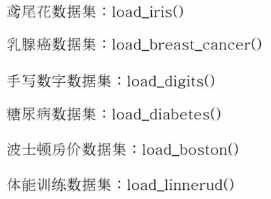
这些数据集都可以在官网上查到,以鸢尾花为例,可以在官网上找到demo,http://scikit-learn.org/stable/auto_examples/datasets/plot_iris_dataset.html
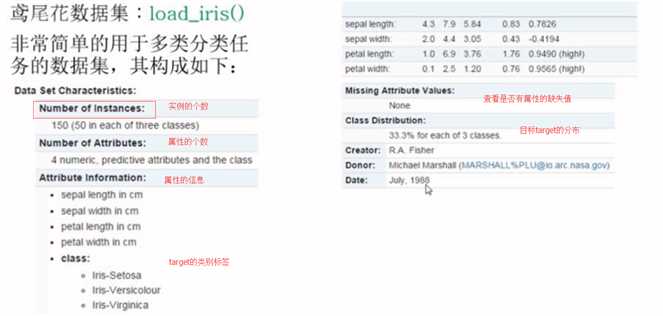
from sklearn.datasets import load_iris
#加载数据集 iris=load_iris() iris.keys() #dict_keys([‘target‘, ‘DESCR‘, ‘data‘, ‘target_names‘, ‘feature_names‘])
#数据的条数和维数 n_samples,n_features=iris.data.shape print("Number of sample:",n_samples) #Number of sample: 150 print("Number of feature",n_features) #Number of feature 4
#第一个样例 print(iris.data[0]) #[ 5.1 3.5 1.4 0.2] print(iris.data.shape) #(150, 4) print(iris.target.shape) #(150,) print(iris.target)
"""
[0 0 0 0 0 0 0 0 0 0 0 0 0 0 0 0 0 0 0 0 0 0 0 0 0 0 0 0 0 0 0 0 0 0 0 0 0
0 0 0 0 0 0 0 0 0 0 0 0 0 1 1 1 1 1 1 1 1 1 1 1 1 1 1 1 1 1 1 1 1 1 1 1 1
1 1 1 1 1 1 1 1 1 1 1 1 1 1 1 1 1 1 1 1 1 1 1 1 1 1 2 2 2 2 2 2 2 2 2 2 2
2 2 2 2 2 2 2 2 2 2 2 2 2 2 2 2 2 2 2 2 2 2 2 2 2 2 2 2 2 2 2 2 2 2 2 2 2
2 2]
""" import numpy as np print(iris.target_names) #[‘setosa‘ ‘versicolor‘ ‘virginica‘] np.bincount(iris.target) #[50 50 50] import matplotlib.pyplot as plt
#以第3个索引为划分依据,x_index的值可以为0,1,2,3 x_index=3 color=[‘blue‘,‘red‘,‘green‘] for label,color in zip(range(len(iris.target_names)),color): plt.hist(iris.data[iris.target==label,x_index],label=iris.target_names[label],color=color) plt.xlabel(iris.feature_names[x_index]) plt.legend(loc="Upper right") plt.show()
#画散点图,第一维的数据作为x轴和第二维的数据作为y轴 x_index=0 y_index=1 colors=[‘blue‘,‘red‘,‘green‘] for label,color in zip(range(len(iris.target_names)),colors): plt.scatter(iris.data[iris.target==label,x_index], iris.data[iris.target==label,y_index], label=iris.target_names[label], c=color) plt.xlabel(iris.feature_names[x_index]) plt.ylabel(iris.feature_names[y_index]) plt.legend(loc=‘upper left‘) plt.show()

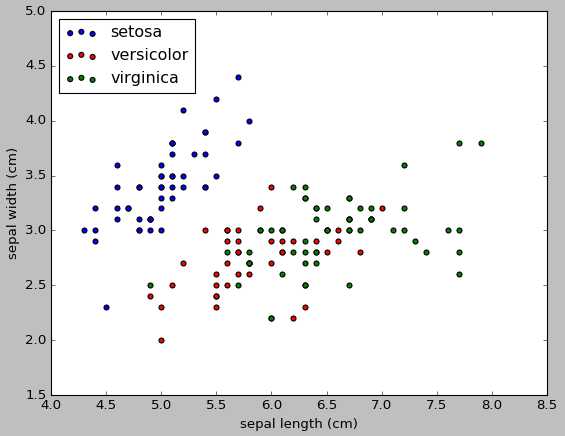
手写数字数据集load_digits():用于多分类任务的数据集
from sklearn.datasets import load_digits digits=load_digits() print(digits.data.shape) import matplotlib.pyplot as plt plt.gray() plt.matshow(digits.images[0]) plt.show() from sklearn.datasets import load_digits digits=load_digits() digits.keys() n_samples,n_features=digits.data.shape print((n_samples,n_features)) print(digits.data.shape) print(digits.images.shape) import numpy as np print(np.all(digits.images.reshape((1797,64))==digits.data)) fig=plt.figure(figsize=(6,6)) fig.subplots_adjust(left=0,right=1,bottom=0,top=1,hspace=0.05,wspace=0.05) #绘制数字:每张图像8*8像素点 for i in range(64): ax=fig.add_subplot(8,8,i+1,xticks=[],yticks=[]) ax.imshow(digits.images[i],cmap=plt.cm.binary,interpolation=‘nearest‘) #用目标值标记图像 ax.text(0,7,str(digits.target[i])) plt.show()
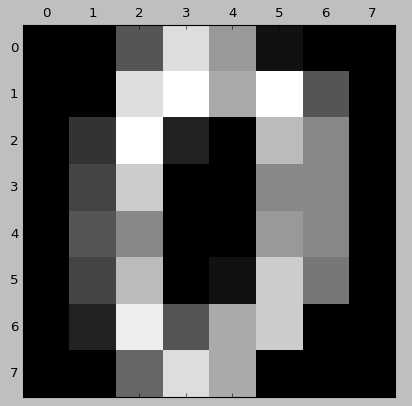
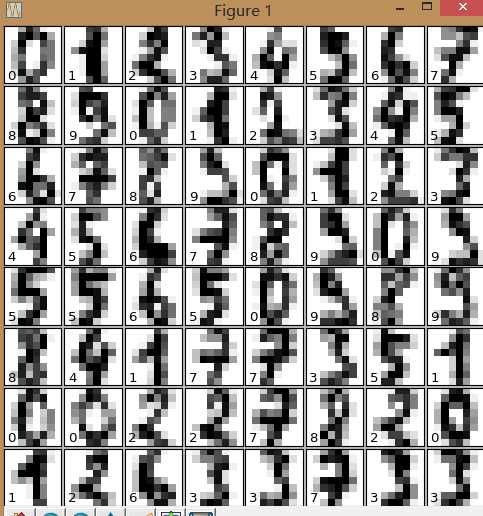
乳腺癌数据集load-barest-cancer():简单经典的用于二分类任务的数据集
糖尿病数据集:load-diabetes():经典的用于回归认为的数据集
值得注意的是,这10个特征中的每个特征都已经被处理成0均值,方差归一化的特征值
波士顿房价数据集:load-boston():经典的用于回归任务的数据集
体能训练数据集:load-linnerud():经典的用于多变量回归任务的数据集,其内部包含两个小数据集:Excise是对3个训练变量的20次观测(体重,腰围,脉搏),physiological是对3个生理学变量的20次观测(引体向上,仰卧起坐,立定跳远)
svmlight/libsvm的每一行样本的存放格式:
<label><feature-id>:<feature-value> <feature-id>:<feature-value> ....
这种格式比较适合用来存放稀疏数据,在sklearn中,用scipy sparse CSR矩阵来存放X,用numpy数组来存放Y
from sklearn.datasets import load_svmlight_file x_train,y_train=load_svmlight_file("/path/to/train_dataset.txt","")#如果要加在多个数据的时候,可以用逗号隔开
生成数据集:可以用来分类任务,可以用来回归任务,可以用来聚类任务,用于流形学习的,用于因子分解任务的
用于分类任务和聚类任务的:这些函数产生样本特征向量矩阵以及对应的类别标签集合
make—blobs:多类单标签数据集,为每个类分配一个或多个正太分布的点集
make-classification:多类单标签数据集,为每个类分配一个或多个正太分布的点集,提供了为数据添加噪声的方式,包括维度相关性,无效特征以及冗余特征等
make—gaussian-quantiles:将一个单高斯分布的点集划分为两个数量均等的点集,作为两类
make-hastie-10-2:产生一个相似的二元分类数据集,有10个维度
make-circle和make-moom产生二维二元分类数据集来测试某些算法的性能,可以为数据集添加噪声,可以为二元分类器产生一些球形判决界面的数据
import numpy as np import matplotlib.pyplot as plt from sklearn.datasets.samples_generator import make_blobs center=[[1,1],[-1,-1],[1,-1]] cluster_std=0.3 X,labels=make_blobs(n_samples=200,centers=center,n_features=2, cluster_std=cluster_std,random_state=0) print(‘X.shape‘,X.shape) print("labels",set(labels)) unique_lables=set(labels) colors=plt.cm.Spectral(np.linspace(0,1,len(unique_lables))) for k,col in zip(unique_lables,colors): x_k=X[labels==k] plt.plot(x_k[:,0],x_k[:,1],‘o‘,markerfacecolor=col,markeredgecolor="k", markersize=14) plt.title(‘data by make_blob()‘) plt.show() from sklearn.datasets.samples_generator import make_classification X,labels=make_classification(n_samples=200,n_features=2,n_redundant=0,n_informative=2, random_state=1,n_clusters_per_class=2) rng=np.random.RandomState(2) X+=2*rng.uniform(size=X.shape) unique_lables=set(labels) colors=plt.cm.Spectral(np.linspace(0,1,len(unique_lables))) for k,col in zip(unique_lables,colors): x_k=X[labels==k] plt.plot(x_k[:,0],x_k[:,1],‘o‘,markerfacecolor=col,markeredgecolor="k", markersize=14) plt.title(‘data by make_classification()‘) plt.show() from sklearn.datasets.samples_generator import make_circles X,labels=make_circles(n_samples=200,noise=0.2,factor=0.2,random_state=1) print("X.shape:",X.shape) print("labels:",set(labels)) unique_lables=set(labels) colors=plt.cm.Spectral(np.linspace(0,1,len(unique_lables))) for k,col in zip(unique_lables,colors): x_k=X[labels==k] plt.plot(x_k[:,0],x_k[:,1],‘o‘,markerfacecolor=col,markeredgecolor="k", markersize=14) plt.title(‘data by make_moons()‘) plt.show()
标签:训练 多个 性能 package ntile img cal gen sam
原文地址:http://www.cnblogs.com/nolonely/p/6980160.html